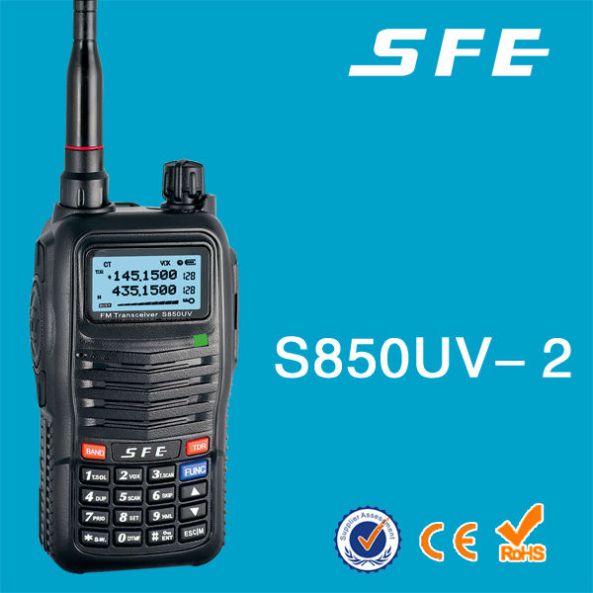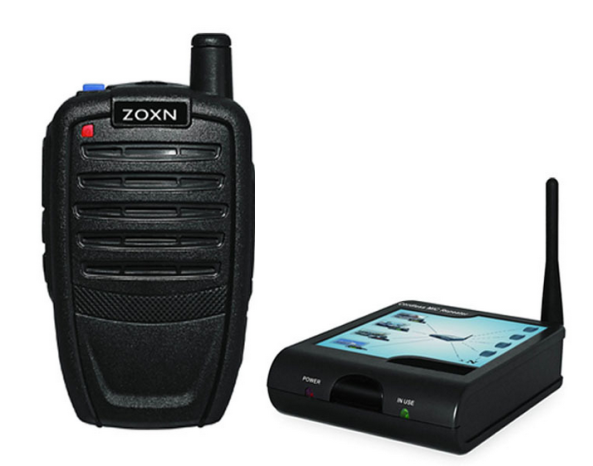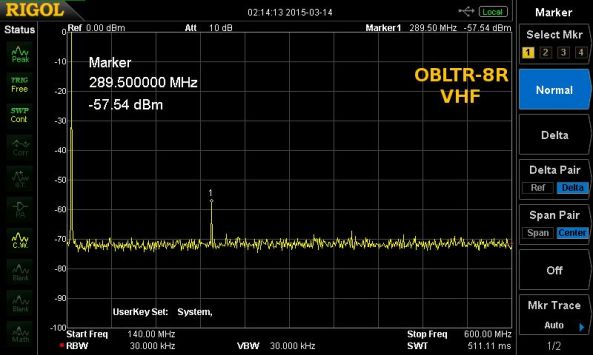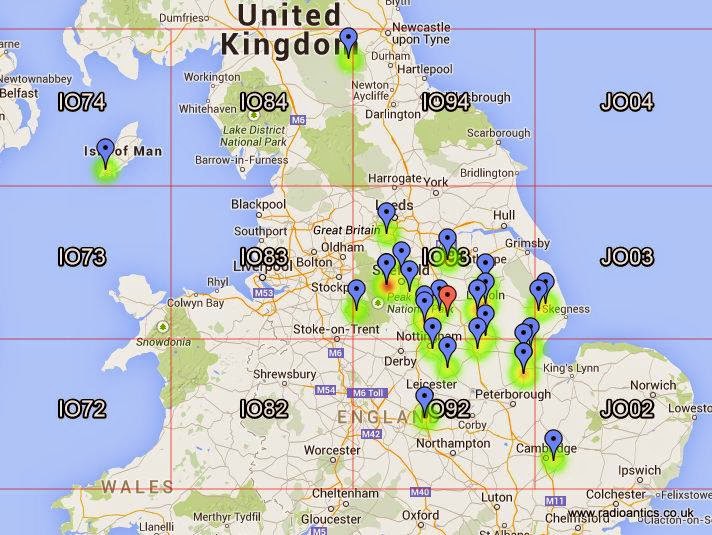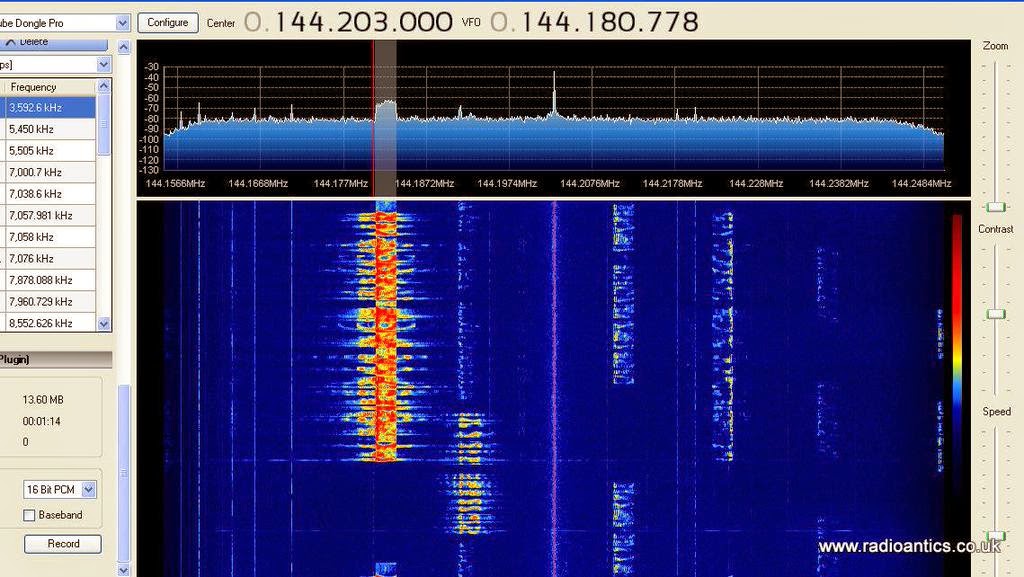Posts Tagged ‘amateurradio.com’
 SFE S850UV-2 – VHF/UHF/1.25 Meters
SFE S850UV-2 – VHF/UHF/1.25 Meters
This radio isn’t anywhere to be found except on Alibaba.com, which basically means that it isn’t available yet. The specs look familiar, except that that it also covers 200-260 MHz. American hams might want to keep an eye on this one.
 Wireless Mobile Radio Microphone
Wireless Mobile Radio Microphone
If it weren’t so expensive ($120 without the microphones) I might have picked one up.
It would only have left me with the problem of the frequencies these microphones use: 221 – 259 MHz. Not allowed here in NL.
- Freely move, easy communication
- Compatible with different brands mobile radio, like Icom, Yaesu, Motorola, Kenwood and so on
- Walkie talkie between hand-microphones
- 500 meters communication range between mobile radio and hand-microphone, between hand-microphones
- Torch light function
- Identification function
| ||||||||||||||||||||||||||||||||||
 Wireless Mobile Radio Microphone
Wireless Mobile Radio Microphone
If it weren’t so expensive ($120 without the microphones) I might have picked one up.
It would only have left me with the problem of the frequencies these microphones use: 221 – 259 MHz. Not allowed here in NL.
- Freely move, easy communication
- Compatible with different brands mobile radio, like Icom, Yaesu, Motorola, Kenwood and so on
- Walkie talkie between hand-microphones
- 500 meters communication range between mobile radio and hand-microphone, between hand-microphones
- Torch light function
- Identification function
| ||||||||||||||||||||||||||||||||||
 Review Anytone OBLTR-8R
Review Anytone OBLTR-8R
by John ‘Miklor’ K3NXU and Hans PD0AC
 I now get a chance to review the OBLTR-8R which is a slightly scaled down version of the TERMN-8R which is the top of the new 8R series offered by Anytone. The only outward difference between the two models is the absence of the orange keys on the left. Once again, when you get one in hand, it becomes very obvious that these radios are were not meant to be competition for the lower end brands, but more of a match for the Wouxun and existing Anytone radios.
I now get a chance to review the OBLTR-8R which is a slightly scaled down version of the TERMN-8R which is the top of the new 8R series offered by Anytone. The only outward difference between the two models is the absence of the orange keys on the left. Once again, when you get one in hand, it becomes very obvious that these radios are were not meant to be competition for the lower end brands, but more of a match for the Wouxun and existing Anytone radios.
This radio is FCC Part 90 certified (Commercial) applications, as well as Part 95A GMRS and 95J MURS services. For GMRS and MURS, the frequencies and power levels hard coded in the firmware. Anyone with dual licenses may now only need to carry a single radio.
What’s in the BOX
There you’ll find the radio, a nicely written and illustrated 104 page English manual, belt clip, wrist strap, Earpiece/Microphone, 7.25 inch (18cm) flexible antenna and hefty 2200mAh 7.4V battery with charger.
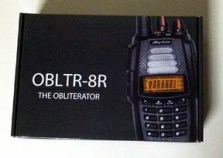
The side of the battery has a small charging jack for the optional 12V mobile charger is available for on the road charging.
First Impressions
The overall weight and feel of the radio is solid. The top of the radio has both a Volume/PowerOn switch and Channel Selector knob. The left side has the PTT button and well as two programmable function buttons. The right side has a 2 pin ‘K2′ Kenwood, Anytone, Wouxun, Baofeng style connector. Programming cables and Spkr/Micr for these radios will be totally compatible.
My prior Anytones have somewhat of a concave keypad, where the OBLTR-8R keypad buttons are level and easier to access. Also, the keypad numbers and definitions are illuminated making manual programming a bit easier.
Transmitter
The OBLTR-8R, like its big brother the TERMN-8R, also has 3 power levels that can be changed from the keypad. In the GMRS and MURS mode, the power levels are fixed, per certification requirements. Audio level and quality reports were excellent.
Receiver
The OBLTR-8R has a single Dual Watch receiver that covers
VHF – 136-174 MHz UHF – 400-520 MHz
FM Broadcast – 64-108 MHz (with 100 memory channels)
It incorporates Fast Scan with a scan rate of approximately 10 channels per second.
Some measurements
Power Levels on the test unit were as follows:
VHF – 5.6W, 1.9W, 0.9W
UHF – 4.75W, 2.3W, 1.2W
GMRS – 4.25W
MURS – 1.8W
Sensitivity
Sensitivity VHF (@ 145 MHz): -126 dBm (@ 50Ω, 12 dB SINAD).
Sensitivity UHF (@ 435 MHz): -125 dBm (@ 50Ω, 12 dB SINAD).
Harmonics
Good numbers: -57.54 dBm on VHF, -54.74 dBm on UHF.
When in the Dual Watch mode, the receiver continuously samples the main and sub-band for activity. To eliminate adjacent channel interference, the radio’s receiver reverts to true Narrowband when selected. A full 1W of audio makes the receive quality both loud and clear.
GMRS and MURS operation (FCC part 95A / 95J certified)
Like its big brother, the OBLTR-8R can be switched to operate on any of three modes. GMRS, MURS or Commercial/Normal. To eliminate the possibility of being on the wrong band, a Key Press at PowerOn selects either GMRS or MURS mode. Channel frequencies are hard coded in the firmware as well as their power levels, but allow for CTCSS/DCS tones can be added/changed via the keypad.
Commercial Application (FCC Part 90 certified)
For Commercial, Fire, EMS and EmComm use, the OBLTR-8R is fully certificated with 2.5kHz steps, and software which prevents Field Programming.
NOAA Weather Alert
The seven US NOAA weather alert frequencies are preprogrammed into the radio. There are 3 options to choose from. ON, OFF and ALERT. When WX Alert is chosen, the NOAA weather channel remains silent in the background until the 1050Hz emergency tone signal is received. This is especially useful in areas where severe weather conditions are prominent.
Dual PTT Capability / Programmable Function Keys
There are two PF keys below the PTT switch. Either can be programmed to function as a sub-channel (lower display) PTT button, while the PTT switch activates the upper channel.
The PF keys can also be used to select your choice of:
– Battery Voltage display
– Frequency display
– Tone Calling (DTMF/5TONE/2TONE)
– FHSS (Frequency Hopping)
– Tone Pulse (1750, 1450, 1000 or 2100Hz)
– Alarm Button
– Dual PTT
– MONI (Squelch off)
Channel Banks
The radio supports 200 channels and 10 memory banks. Scanning Group 0 will scan all programmed channels entered into the transceiver. Banks 1 > 9 can be assigned up to 32 channels each.
I found a nice added feature that isn’t on my 3318UV-A. If I want to remove a channel from a particular bank, I can dial in the channel, press two keys, turn the knob and it’s gone. Eliminates the need to me to use the computer to delete the bad ones.
2TONE Sequential Paging
This is extremely useful for the EMS user. I personally have used 2 tone pagers in the past. I can now monitor local EMS channels with one radio.
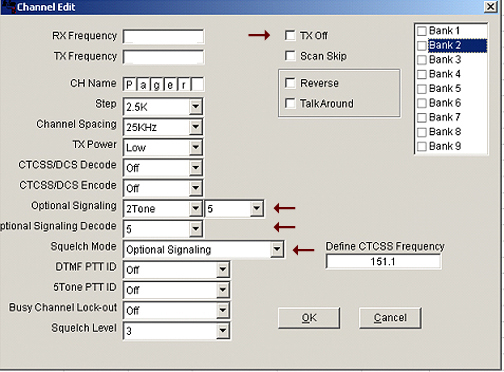 Detailed instructions on how to set up the 2-tone and 5-tone paging system can be found HERE.
Detailed instructions on how to set up the 2-tone and 5-tone paging system can be found HERE.
Software
The OEM software is relatively easy to follow, and with a little practice, easy to navigate. Some areas may be a bit tricky, and I’ll try to address those area in the Miklor FAQ section. CHIRP developers are aware of the new Anytone 8R series, but it takes time to backward engineer a radios software.
As always, it is recommended to get a quality programming cable so you spend more time talking on the radio and less time loading special drivers to your PC. I personally use an FTDI cable that is Plug ‘n Play with no driver issues.
Upgradeable Firmware
The OBLTR-8R has Upgradeable Firmware. If features are added in the future, your radio is not obsolete. The firmware can be updated (re-flashed) by an authorized dealer so you will always be able to have the latest version available to you.
IMHO
The developers of the Anytone OBLTR-8R packed a lot of features in a small package. The inclusion of:
– Certified GMRS, MURS and Commercial in one radio
– Upgradeable Firmware
– 200 channels/10 Banks
– Dual PTT
– 2TONE / 5TONE / MSK Messaging
– Stun / Kill capability
at a price tag under $100 level is pretty darned impressive.
Comparison
There are four models in the 8R series. At the top is the TERMN-8R, followed by the OBLTR-8R, NSTIG-8R, and the ANILE-8R. Confusing? Here’s a hint. They are alphabetical. That’s the only way I can keep them straight.
For a comparison between the OBLTR-8R and the others in the 8R series, you can follow this LINK
Price: $98.89 USD (Amazon)
More Information: Anytone Tech, Miklor.com
 Review Anytone OBLTR-8R
Review Anytone OBLTR-8R
by John ‘Miklor’ K3NXU and Hans PD0AC
 I now get a chance to review the OBLTR-8R which is a slightly scaled down version of the TERMN-8R which is the top of the new 8R series offered by Anytone. The only outward difference between the two models is the absence of the orange keys on the left. Once again, when you get one in hand, it becomes very obvious that these radios are were not meant to be competition for the lower end brands, but more of a match for the Wouxun and existing Anytone radios.
I now get a chance to review the OBLTR-8R which is a slightly scaled down version of the TERMN-8R which is the top of the new 8R series offered by Anytone. The only outward difference between the two models is the absence of the orange keys on the left. Once again, when you get one in hand, it becomes very obvious that these radios are were not meant to be competition for the lower end brands, but more of a match for the Wouxun and existing Anytone radios.
This radio is FCC Part 90 certified (Commercial) applications, as well as Part 95A GMRS and 95J MURS services. For GMRS and MURS, the frequencies and power levels hard coded in the firmware. Anyone with dual licenses may now only need to carry a single radio.
What’s in the BOX
There you’ll find the radio, a nicely written and illustrated 104 page English manual, belt clip, wrist strap, Earpiece/Microphone, 7.25 inch (18cm) flexible antenna and hefty 2200mAh 7.4V battery with charger.

The side of the battery has a small charging jack for the optional 12V mobile charger is available for on the road charging.
First Impressions
The overall weight and feel of the radio is solid. The top of the radio has both a Volume/PowerOn switch and Channel Selector knob. The left side has the PTT button and well as two programmable function buttons. The right side has a 2 pin ‘K2’ Kenwood, Anytone, Wouxun, Baofeng style connector. Programming cables and Spkr/Micr for these radios will be totally compatible.
My prior Anytones have somewhat of a concave keypad, where the OBLTR-8R keypad buttons are level and easier to access. Also, the keypad numbers and definitions are illuminated making manual programming a bit easier.
Transmitter
The OBLTR-8R, like its big brother the TERMN-8R, also has 3 power levels that can be changed from the keypad. In the GMRS and MURS mode, the power levels are fixed, per certification requirements. Audio level and quality reports were excellent.
Receiver
The OBLTR-8R has a single Dual Watch receiver that covers
VHF – 136-174 MHz UHF – 400-520 MHz
FM Broadcast – 64-108 MHz (with 100 memory channels)
It incorporates Fast Scan with a scan rate of approximately 10 channels per second.
Some measurements
Power Levels on the test unit were as follows:
VHF – 5.6W, 1.9W, 0.9W
UHF – 4.75W, 2.3W, 1.2W
GMRS – 4.25W
MURS – 1.8W
Sensitivity
Sensitivity VHF (@ 145 MHz): -126 dBm (@ 50Ω, 12 dB SINAD).
Sensitivity UHF (@ 435 MHz): -125 dBm (@ 50Ω, 12 dB SINAD).
Harmonics
Good numbers: -57.54 dBm on VHF, -54.74 dBm on UHF.
When in the Dual Watch mode, the receiver continuously samples the main and sub-band for activity. To eliminate adjacent channel interference, the radio’s receiver reverts to true Narrowband when selected. A full 1W of audio makes the receive quality both loud and clear.
GMRS and MURS operation (FCC part 95A / 95J certified)
Like its big brother, the OBLTR-8R can be switched to operate on any of three modes. GMRS, MURS or Commercial/Normal. To eliminate the possibility of being on the wrong band, a Key Press at PowerOn selects either GMRS or MURS mode. Channel frequencies are hard coded in the firmware as well as their power levels, but allow for CTCSS/DCS tones can be added/changed via the keypad.
Commercial Application (FCC Part 90 certified)
For Commercial, Fire, EMS and EmComm use, the OBLTR-8R is fully certificated with 2.5kHz steps, and software which prevents Field Programming.
NOAA Weather Alert
The seven US NOAA weather alert frequencies are preprogrammed into the radio. There are 3 options to choose from. ON, OFF and ALERT. When WX Alert is chosen, the NOAA weather channel remains silent in the background until the 1050Hz emergency tone signal is received. This is especially useful in areas where severe weather conditions are prominent.
Dual PTT Capability / Programmable Function Keys
There are two PF keys below the PTT switch. Either can be programmed to function as a sub-channel (lower display) PTT button, while the PTT switch activates the upper channel.
The PF keys can also be used to select your choice of:
– Battery Voltage display
– Frequency display
– Tone Calling (DTMF/5TONE/2TONE)
– FHSS (Frequency Hopping)
– Tone Pulse (1750, 1450, 1000 or 2100Hz)
– Alarm Button
– Dual PTT
– MONI (Squelch off)
Channel Banks
The radio supports 200 channels and 10 memory banks. Scanning Group 0 will scan all programmed channels entered into the transceiver. Banks 1 > 9 can be assigned up to 32 channels each.
I found a nice added feature that isn’t on my 3318UV-A. If I want to remove a channel from a particular bank, I can dial in the channel, press two keys, turn the knob and it’s gone. Eliminates the need to me to use the computer to delete the bad ones.
2TONE Sequential Paging
This is extremely useful for the EMS user. I personally have used 2 tone pagers in the past. I can now monitor local EMS channels with one radio.
 Detailed instructions on how to set up the 2-tone and 5-tone paging system can be found HERE.
Detailed instructions on how to set up the 2-tone and 5-tone paging system can be found HERE.
Software
The OEM software is relatively easy to follow, and with a little practice, easy to navigate. Some areas may be a bit tricky, and I’ll try to address those area in the Miklor FAQ section. CHIRP developers are aware of the new Anytone 8R series, but it takes time to backward engineer a radios software.
As always, it is recommended to get a quality programming cable so you spend more time talking on the radio and less time loading special drivers to your PC. I personally use an FTDI cable that is Plug ‘n Play with no driver issues.
Upgradeable Firmware
The OBLTR-8R has Upgradeable Firmware. If features are added in the future, your radio is not obsolete. The firmware can be updated (re-flashed) by an authorized dealer so you will always be able to have the latest version available to you.
IMHO
The developers of the Anytone OBLTR-8R packed a lot of features in a small package. The inclusion of:
– Certified GMRS, MURS and Commercial in one radio
– Upgradeable Firmware
– 200 channels/10 Banks
– Dual PTT
– 2TONE / 5TONE / MSK Messaging
– Stun / Kill capability
at a price tag under $100 level is pretty darned impressive.
Comparison
There are four models in the 8R series. At the top is the TERMN-8R, followed by the OBLTR-8R, NSTIG-8R, and the ANILE-8R. Confusing? Here’s a hint. They are alphabetical. That’s the only way I can keep them straight.
For a comparison between the OBLTR-8R and the others in the 8R series, you can follow this LINK
Price: $98.89 USD (Amazon)
More Information: Anytone Tech, Miklor.com
 A dark cold evening in a layby
A dark cold evening in a layby
Several hours sitting in the car on the side of a deserted road in the dark and cold was worth it. Despite some initial trepidation I really enjoyed the experience until I got spooked at the end.
Like the last time I operated from this location I put the small yagi approximately 3-4 metres up on the top of my 'painters' telescopic pole stuck in to a parasol stand. I sat in the car and reached out the open window to rotate the pole as required. I wrapped up well and had a blanket over my legs and a woolly hat on and kept surprising warm despite it being just 1°C, turning the courtesy light on only when I needed to write in the log.
It was nice to be noise free and I made 29 contacts, nothing earth shattering but with a modest set up and operating in the AL section (10W max) I was more than happy and got my first contact in the Isle of Man.
From the reports posted on line it seems conditions were flat and activity was low. Frustratingly several times I found a distant station only for it to be drowned out by splatter. I know some of this is down to my radio and the antenna but the source is nearby and so strong that even turning the beam makes little difference. Ironically being higher up meant the signal was even stronger than I experience at home.
The annoyance is compounded by the operator's habit of regularly changing calling frequency seemingly with little regard of who is currently operating there. This SDR screen capture shows an example of the same contesters signal during a recent 2m UKAC. Captured using a vertical collinear several strong clean(er) signals are clearly visible even with the mismatched polarisation. Sadly it is not a one-off and I have observed similar splatter from this source during both 70cms and 6m contests.
It was very dark and eerie on the quiet road and I'm afraid I got spooked with 20 minutes of the contest left, a 4x4 drove past slowly and appeared to shine a spotlight at my car. I was midway through a QSO writing in the logbook so I only caught it out of the corner of my eye so wasn't sure if they did. But a while later I saw what looked like torch beams moving in the nearby field that seemed to be getting closer. In retrospect it was nothing untoward when I checked the map later there are farm buildings in that direction but I've seen one too many horror films so decided not to hang about so threw everything in the car and headed home with out looking back..
.... you'll see him if you look
 Review Anytone NSTIG-8R
Review Anytone NSTIG-8R
 The NSTIG-8R was the first radio I tried out, mainly because it came with a fully charged battery. I punched in some frequencies and took off on a 5-mile walk. The radio performed quite well.
The NSTIG-8R was the first radio I tried out, mainly because it came with a fully charged battery. I punched in some frequencies and took off on a 5-mile walk. The radio performed quite well.
In the box:
- Radio
- 1800 mAh battery
- Antenna (SMA female)
- Simple headset
- Charger
- AC adapter (110-240 Volts)
- Belt clip
- Wrist strap
- Manual
Factory specifications
Frequency range: [TX/RX] 136 – 174MHz, 400 – 520MHz
RX only: 68-108MHz (FM Broadcast)
Channel Capacity: 200 Channels
Channel Spacing: 25KHz (wide band)12.5KHz (narrow band)
Sensitivity: ≤0.25μV (wide band) ≤0.35μV (narrow band)
Operation Voltage: 7.4V DC ±20%
Battery: 1800mAh
Frequency steps (KHz): 2.5, 5, 6.25, 10, 12.5, 20, 25, 30 and 50
Antenna: SMA-Female
Accessory Connector: Kenwood 2-Pin standard
Stability: ±2.5 ppm
Output power: 5W / 1W
Size: 113×62×40mm (with battery)
Weight: 220g (with battery, antenna, belt clip)
Audio Power Output: 1000mW
Build quality
The first thing I noticed is the weight of the NSTIG-8R. While the dimensions of the radio are nearly identical to those of a UV-5R, this radio is quite a bit heavier: 129 grams vs 91 grams (without battery and antenna). With all the bells & whistles attached the scale shows 240 grams vs 209 grams. All in all the radio has a solid feel to it.
Side keys
The NSTIG-8R has three side keys also, and these can be programmed by the user. At default the upper key will switch on the flashlight, the middle one will show you the remaining battery voltage, and the last one will bypass the squelch (monitor).
Dual PTT
If you like you can reprogram one of the side keys to function as PTT for VFO B. The main PTT key is reserved for VFO A and can’t be re-assigned.
Display
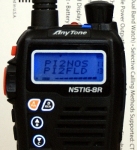 At default the three-color display (amber, blue or purple) shows two frequencies at the same time and will be in dual watch mode. There’s no ‘TDR’ option in the menu; if you want to switch off dual watch you press Function+Main to toggle between dual watch and single band mode.
At default the three-color display (amber, blue or purple) shows two frequencies at the same time and will be in dual watch mode. There’s no ‘TDR’ option in the menu; if you want to switch off dual watch you press Function+Main to toggle between dual watch and single band mode.
In single band mode you can switch between VFO A en B by just pressing the Main key. The system takes a little bit time to get used to.
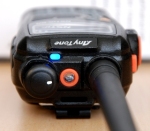 Nice touch: even when attached to your belt you can see which VFO is active. When the RX LED turns green the upper VFO is active, when turning blue the lower VFO is active. Contrary to a Baofeng you can select VFO mode or memory mode for each individual VFO.
Nice touch: even when attached to your belt you can see which VFO is active. When the RX LED turns green the upper VFO is active, when turning blue the lower VFO is active. Contrary to a Baofeng you can select VFO mode or memory mode for each individual VFO.
The S-meter is one that actually works. Meters on hand helds are never accurate enough to give a meaningful signal report, but at least you get a basic idea of the field strength.
Programming
Most of the programming can be done from the keypad, including alpha tags. The software is necessary to change the welcome message, or give the radio its own ID and pre-programmed DTMF sequences — something you will need if you decide to use individual or group calling. You can do a lot manually, which will come in handy in the field, but using the software will work faster and give you access to a lot of other options.
I think it’s really a shame that there’s no Help section in the software. With basic channel-editing software I couldn’t care less, but this program offers quite a few exotic options. I guess that figuring it all out will be left to us, after which we can document it on Miklor.com.
Memories
You can program 200 VHF/UHF frequencies and 99 FM broadcast frequencies. I won’t be able to fill that up easily, but I’m sure there will be others who won’t have any problems filling these up to the max.
Scanning
Most Chinese radios are poor, painfully slow scanners. For the first time in years I can report that scan speed is actually acceptable: about 4-5 channels/second. Not brilliant, but usable. The top models in the 8R series have a Fast Scan mode which clocks at 10 channels/second.
The NSTIG-8R can scan for CTCSS/DCS codes, and you can set VFO scanning limits.
Bugs
Haven’t been able to find one.
Various measurements
TX audio: loud and clear, just like the ANILE-8R. No complaints.
RX audio: Same story: loud and clear, with no noticeable distortion.
Sensitivity VHF (@ 145 MHz): -127 dBm (@ 50Ω, 12 dB SINAD).
Sensitivity UHF (@ 435 MHz): -125 dBm (@ 50Ω, 12 dB SINAD).
Frequency accuracy of this sample: VHF: 0 Hz, UHF -13 Hz.
Power output VHF (@145 MHz): 1.3 Watts / 4.9 Watts.
Power output UHF (@435 MHz): 1.1 Watts / 4.3 Watts.
Front-end: good, but not as good as the Wouxun KG-UV6D or QuanSheng TG-UV2.
Harmonic suppression: three measurable harmonics on VHF, varying between -53.05 dBm and -60.20 dBm, on UHF there’s only one at -57.33 dBm.
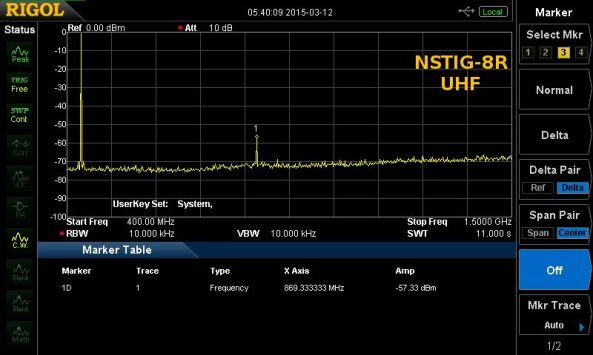 Conclusion
Conclusion
I really like the NSTIG-8R. The design is refreshing, the radio offers more functionality than the average low cost radio, and it’s built like a tank.
The price of the radio is twice that of a Baofeng and half that of a basic(*) Yaesu FT-60. I understand people muttering about prices (it’s the first thing we hams do, it must be in our DNA), but the relation between price and quality is right on target here.
There’s always a choice: you go for the cheapest, for the best, or for something in between. Seen from that perspective the NSTIG-8R nicely fills the gap between Baofengs and Yaesu’s entry level radio.
(*) The Yaesu FT-60 does not come with a desktop charger, 1800 mAh battery or headset – you need to add about $120 for these accessories)
Price: $68.89 (Amazon)
More information: Anytone Tech
